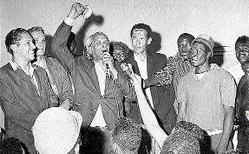Hartley Neita, Contributor

"I am happy to shake a bell from which the tongue has been cut out," Norman Manley, the Leader of the Opposition, declares as he makes a joke of the Jamaica Labour Party's election symbol, after the announcement of victory by his party's candidate, Vivian Blake (fourth right), Q.C., in a 1967 by-election in South East St. Elizabeth. Manley and Blake are surrounded by party supporters in the Malvern Courthouse, where the parliamentary counting took place. Looking on are David Coore (left), Q.C., and Michael Manley (second left), both members of the House. - File
Before the first general election in 1944, when for the first time every Jamaican over the age of 21 could vote, it was recognised that over 50 per cent of these first-time voters were illiterate. These illiterates would, therefore, have a problem identifying the names of the candidates for whom they wished to vote.
As a result, the Electoral Office announced that candidates would be identified by symbols on the ballot papers. The symbols were The Hand, The Star, Head, Horseshoe, Bird, Bell, Woman, Tree, Bus, Hoop, Crossed Hammers and Heart. The drill was that the candidate whose surname started with the earlier letter of the alphabet took the first symbol, and the next candidate the second symbol, and so on, all in the alphabetical order of the candidates' surnames.
Because of this, Gideon Gallimore of North West St. Ann changed his name by deed poll to Aabuthnott Gallimore to ensure that his name was first on the ballot paper. His reason was that with a highly illiterate electorate, those voters would vote for the first name on the ballot paper. This did not help him the first time this name was used.
Good-luck symbolism
The Star, which had a good-luck symbolism, was also seen as good fortune to have and to hold. Candidates were, therefore, known to arrange for the nomination of someone whose names began with an earlier initial than theirs, to be nominated, so that being secondon the ballot paper they would obtain the Star as their symbol.
Both parties then wisely put an end to that individual scrambling for symbols by agreeing that all candidates for one party should take the same symbol - the Head for the PNP and the Hand for the JLP - leaving the chief electoral officer to assign symbols to other candidates.
When the referendum came along, both parties felt that normal election symbols should not be used. The PNP chose the Federal Flag and the JLP the map of Jamaica. It was then realised that this was illegal as these were not the prescribed symbols, so the parties had to revert to symbols listed in the law. Even then, the parties considered that they should not use their normal election symbols; so the PNP chose the Tree and the JLP chose the Bell, the latter ringing themselves to success in the referendum.
Both parties squabbled
For the elections in 1962 which followed the referendum, both parties squabbled over the use of symbols. The JLP wished to carry over into these elections the campaign value of the Bell, while the PNP did not wish to allow them that ringing advantage. It was subsequently revealed that the symbols were never intended to have an emotional value but were merely a guide to illiterates. For the 1962 elections therefore, the parties reverted to the Head and the Hand which they had only varied in 1961 because they each thought, and rightly so, that the referendum was not an election.
With the passage of time, the JLP adopted the Bell as its symbol on the ballot, which led to The Gleaner commenting that it seemed the JLP thought that people would not be persuaded to vote for a party, but would vote for a Bell. The PNP has retained the Head as its symbol.

